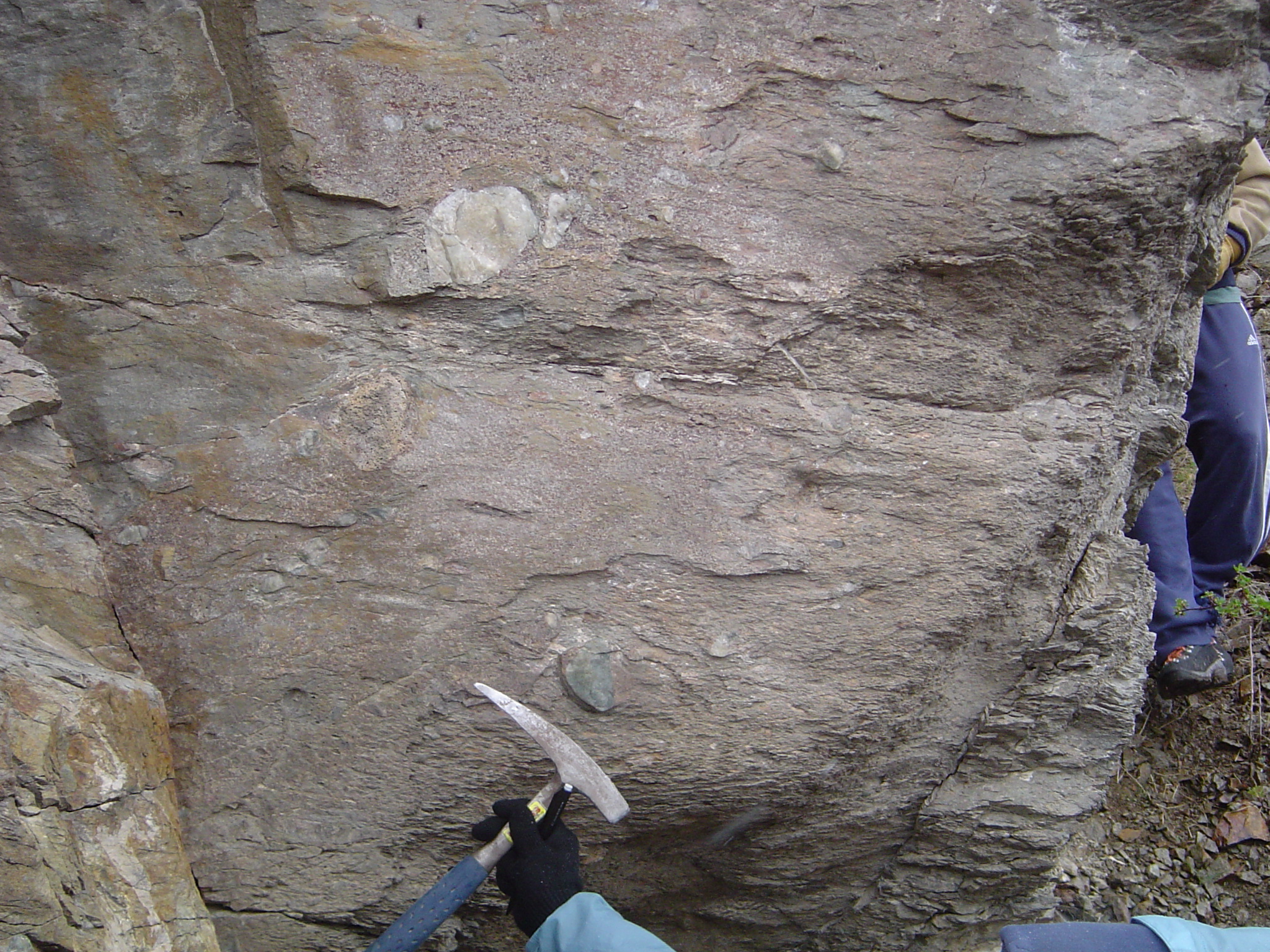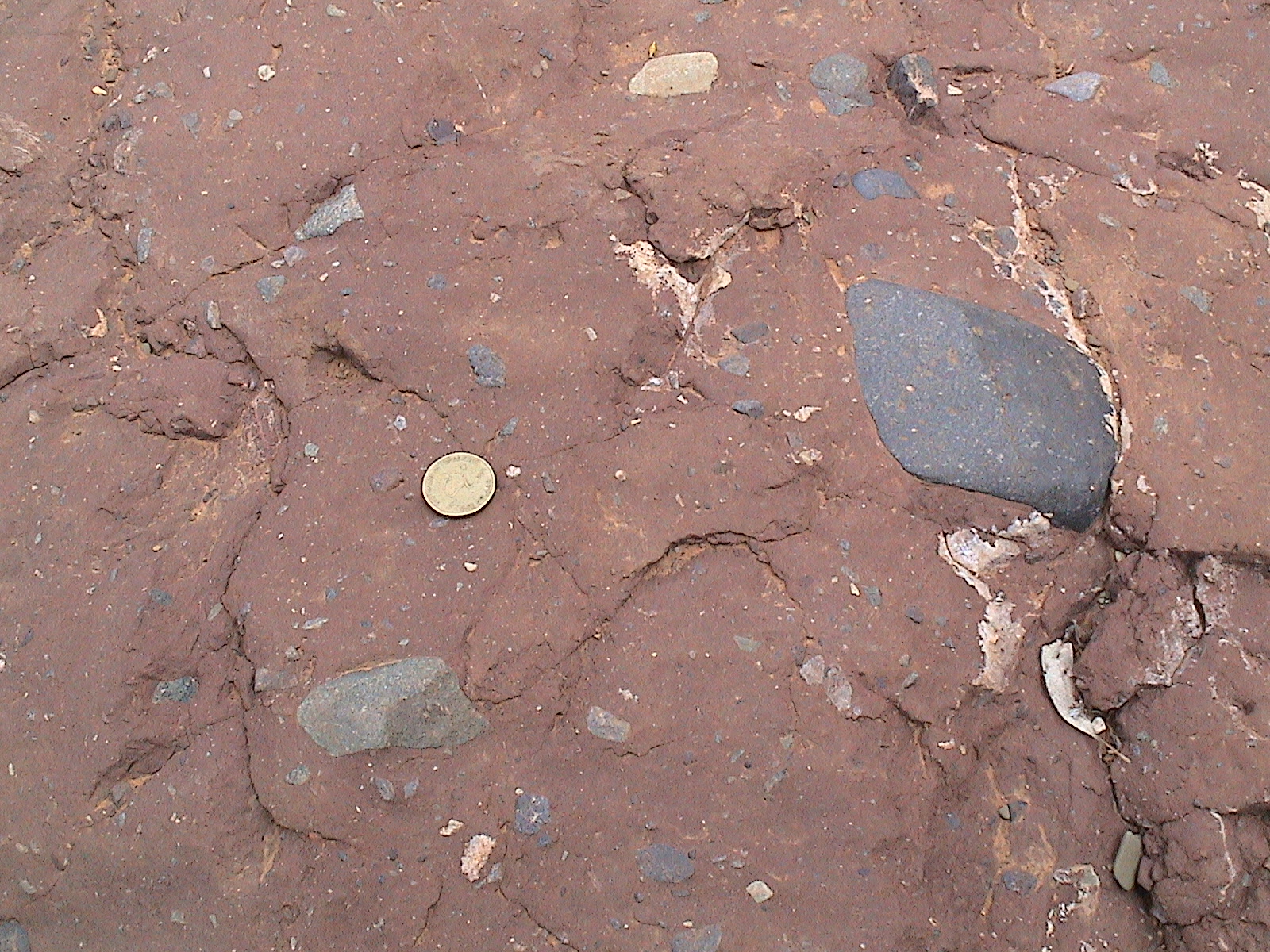Diamictite on:
[Wikipedia]
[Google]
[Amazon]



 Diamictite (; from Ancient Greek (): 'through' and (): 'mixed') is a type of lithified
Diamictite (; from Ancient Greek (): 'through' and (): 'mixed') is a type of lithified
Huber, H., Koeberl, C., McDonald, I., Reimold, W.U.: ''Geochemistry and petrology of Witwatersrand and Dwyka diamictites from South Africa: Search for an extraterrestrial component.'' Geochimica et Cosmochimica Acta, Vol. 65, No. 12, pp. 2007–2016, 2001. (pdf 470 Kb)
/ref> * glacial origin ** meltwater flow deposition ** unsorted
Illustration of a Canadian diamictite
{{Rock type Sedimentary rocks
sedimentary rock
Sedimentary rocks are types of rock (geology), rock formed by the cementation (geology), cementation of sediments—i.e. particles made of minerals (geological detritus) or organic matter (biological detritus)—that have been accumulated or de ...
that consists of nonsorted to poorly sorted terrigenous sediment
In oceanography, terrigenous sediments are those derived from the erosion of rocks on land; that is, they are derived from ''terrestrial'' (as opposed to marine) environments. Consisting of sand, mud, and silt carried to sea by rivers, their c ...
containing particles that range in size from clay
Clay is a type of fine-grained natural soil material containing clay minerals (hydrous aluminium phyllosilicates, e.g. kaolinite, ). Most pure clay minerals are white or light-coloured, but natural clays show a variety of colours from impuriti ...
to boulders
In geology, a boulder (or rarely bowlder) is a rock fragment with size greater than in diameter. Smaller pieces are called cobbles and pebbles. While a boulder may be small enough to move or roll manually, others are extremely massive. In c ...
, suspended in a matrix
Matrix (: matrices or matrixes) or MATRIX may refer to:
Science and mathematics
* Matrix (mathematics), a rectangular array of numbers, symbols or expressions
* Matrix (logic), part of a formula in prenex normal form
* Matrix (biology), the m ...
of mudstone
Mudstone, a type of mudrock, is a fine-grained sedimentary rock whose original constituents were clays or muds. Mudstone is distinguished from ''shale'' by its lack of fissility.Blatt, H., and R.J. Tracy, 1996, ''Petrology.'' New York, New York, ...
or sandstone
Sandstone is a Clastic rock#Sedimentary clastic rocks, clastic sedimentary rock composed mainly of grain size, sand-sized (0.0625 to 2 mm) silicate mineral, silicate grains, Cementation (geology), cemented together by another mineral. Sand ...
. The term was coined by Richard Foster Flint and others as a purely descriptive term, devoid of any reference to a particular origin.Flint, R.F., J.E. Sanders, and J. Rodgers (1960) ''Diamictite, a substitute term for symmictite'' Geological Society of America Bulletin. 71(12):1809–1810. Some geologist
A geologist is a scientist who studies the structure, composition, and History of Earth, history of Earth. Geologists incorporate techniques from physics, chemistry, biology, mathematics, and geography to perform research in the Field research, ...
s restrict the usage to nonsorted or poorly sorted conglomerate or breccia
Breccia ( , ; ) is a rock composed of large angular broken fragments of minerals or Rock (geology), rocks cementation (geology), cemented together by a fine-grained matrix (geology), matrix.
The word has its origins in the Italian language ...
that consists of sparse, terrigenous gravel
Gravel () is a loose aggregation of rock fragments. Gravel occurs naturally on Earth as a result of sedimentation, sedimentary and erosion, erosive geological processes; it is also produced in large quantities commercially as crushed stone.
Gr ...
suspended in either a mud or sand matrix. Tucker, M.E. (2003) ''Sedimentary Rocks in the Field'' John Wiley & Sons, Ltd., New York, New York. 244 pp.
Unlithified diamictite is referred to as diamicton Diamicton (also diamict) (from Greek ''δια'' (dia-): through and ''μεικτός'' (meiktós): mixed) is a terrigenous sediment (a sediment resulting from dry-land erosion) that is unsorted to poorly sorted and contains particles ranging in siz ...
.
The term diamictite is often applied to nonsorted or poorly sorted, lithified glacial deposits such as glacial tillite and boulder clay
Boulder clay is an unsorted agglomeration of clastic sediment that is unstratified and structureless and contains gravel of various sizes, shapes, and compositions distributed at random in a fine-grained matrix. The fine-grained matrix consists o ...
, and diamictites are often mistakenly interpreted as having an essentially glacial
A glacier (; or ) is a persistent body of dense ice, a form of rock, that is constantly moving downhill under its own weight. A glacier forms where the accumulation of snow exceeds its ablation over many years, often centuries. It acquires ...
origin (see Snowball Earth
The Snowball Earth is a historical geology, geohistorical hypothesis that proposes that during one or more of Earth's greenhouse and icehouse Earth, icehouse climates, the planet's planetary surface, surface became nearly entirely freezing, fr ...
). The most common origin for diamictites, however, is deposition by submarine mass flows like turbidites and olistostromes in tectonically active areas, and they can be produced in a wide range of other geological conditions. Possible origins include:Eyles, N.; Januszczak, N. (2004). "’Zipper-rift’: A tectonic model for Neoproterozoic glaciations during the breakup of Rodinia after 750 Ma". Earth-Science Reviews 65 (1-2): 1-73. (pdf 4 Mb)/ref> * glacial origin ** meltwater flow deposition ** unsorted
moraine
A moraine is any accumulation of unconsolidated debris (regolith and Rock (geology), rock), sometimes referred to as glacial till, that occurs in both currently and formerly glaciated regions, and that has been previously carried along by a gla ...
glacial till
image:Geschiebemergel.JPG, Closeup of glacial till. Note that the larger grains (pebbles and gravel) in the till are completely surrounded by the matrix of finer material (silt and sand), and this characteristic, known as ''matrix support'', is d ...
** basal melt-out
** ice rafted sediments deposited by melting icebergs or disintegrating ice sheets (dropstone
Dropstones are isolated fragments of rock found within finer-grained water-deposited sedimentary rocks or pyroclasts, pyroclastic beds. They range in size from small pebbles to boulders. The critical distinguishing feature is that there is eviden ...
s)
* volcanic
A volcano is commonly defined as a vent or fissure in the crust of a planetary-mass object, such as Earth, that allows hot lava, volcanic ash, and gases to escape from a magma chamber below the surface.
On Earth, volcanoes are most often fo ...
origin
** lahar
A lahar (, from ) is a violent type of mudflow or debris flow composed of a slurry of Pyroclastic rock, pyroclastic material, rocky debris and water. The material flows down from a volcano, typically along a valley, river valley.
Lahars are o ...
s
** lahar mass flows entering the ocean
* marine origin
** debris flow
Debris flows are geological phenomena in which water-laden masses of soil and fragmented Rock (geology), rock flow down mountainsides, funnel into stream channels, entrain objects in their paths, and form thick, muddy deposits on valley floors. ...
** turbiditic olistostrome
An olistostrome is a sedimentary deposit composed of a chaotic mass of heterogeneous material, such as blocks and mud, known as olistoliths, that accumulates as a semifluid body by submarine (geology), submarine gravity sliding or Slump (geology ...
s
** mixing of sediments by submarine landslides
* tectonic
Tectonics ( via Latin ) are the processes that result in the structure and properties of the Earth's crust and its evolution through time. The field of ''planetary tectonics'' extends the concept to other planets and moons.
These processes ...
origin
** fault gouge
Fault gouge is a type of fault rock best defined by its grain size. It is found as incohesive fault rock (rock which can be broken into its component granules at the present outcrop, only aided with fingers/pen-knife), with less than 30% clasts ...
* erosion
Erosion is the action of surface processes (such as Surface runoff, water flow or wind) that removes soil, Rock (geology), rock, or dissolved material from one location on the Earth's crust#Crust, Earth's crust and then sediment transport, tran ...
al origin
** regolith
Regolith () is a blanket of unconsolidated, loose, heterogeneous superficial deposits covering solid rock. It includes dust, broken rocks, and other related materials and is present on Earth, the Moon, Mars, some asteroids, and other terrestria ...
, in the form of a debris flow
Debris flows are geological phenomena in which water-laden masses of soil and fragmented Rock (geology), rock flow down mountainsides, funnel into stream channels, entrain objects in their paths, and form thick, muddy deposits on valley floors. ...
** other mass wasting
Mass wasting, also known as mass movement, is a general term for the movement of rock (geology), rock or soil down slopes under the force of gravity. It differs from other processes of erosion in that the debris transported by mass wasting is no ...
events
* extraterrestrial origin
** impact breccia
References
Further reading
* Deynoux, M., et al. (Editors) (2004) ''Earth's Glacial Record'', Cambridge University Press, pp. 34–39External links
Illustration of a Canadian diamictite
{{Rock type Sedimentary rocks